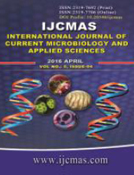


 National Academy of Agricultural Sciences (NAAS)
National Academy of Agricultural Sciences (NAAS)

|
PRINT ISSN : 2319-7692
Online ISSN : 2319-7706 Issues : 12 per year Publisher : Excellent Publishers Email : editorijcmas@gmail.com / submit@ijcmas.com Editor-in-chief: Dr.M.Prakash Index Copernicus ICV 2018: 95.39 NAAS RATING 2020: 5.38 |
Higher level of microbial contamination in indoor air is a serious problem of recent health concern. The air of representative areas, viz., Lecture Hall, M.Sc. Lab and Dean Office of University Campus in Jodhpur, Rajasthan (India) was analyzed to determine the level of fungal types most frequently found in suspension. Samples were collected by open plate technique during winter, summer and monsoon seasons 2013-14 and viable fungal counts were determined. The mean seasonal concentrations of total airborne fungi in the University Campus ranged from 16.39-32.22 CFU/m3 in selected indoor sampling sites. In outdoor it ranged from 50.83-70 CFU/m3. There was not any significant difference in the concentrations of fungi between unoccupied and occupied conditions. Also, a comparison between indoor and outdoor fungal population densities showed that the fungal concentration was higher outside than inside. Different sites showed different concentration of airborne viable fungi and observed the following trend among locations- Dean Office > Lecture Hall >M.Sc. Lab. In the present study, a total of 8 types of fungal genera isolated from the air of University Campus. These included Aspergillus (Aspergillus niger, Aspergillus fumigates, Aspergillus flavus, Aspergillus terreus), Alternaria, Cladosporium, Fusarium, Helminthosporium, Penicillium, Rhizopus and Yeast.
 |
 |
 |
 |
 |